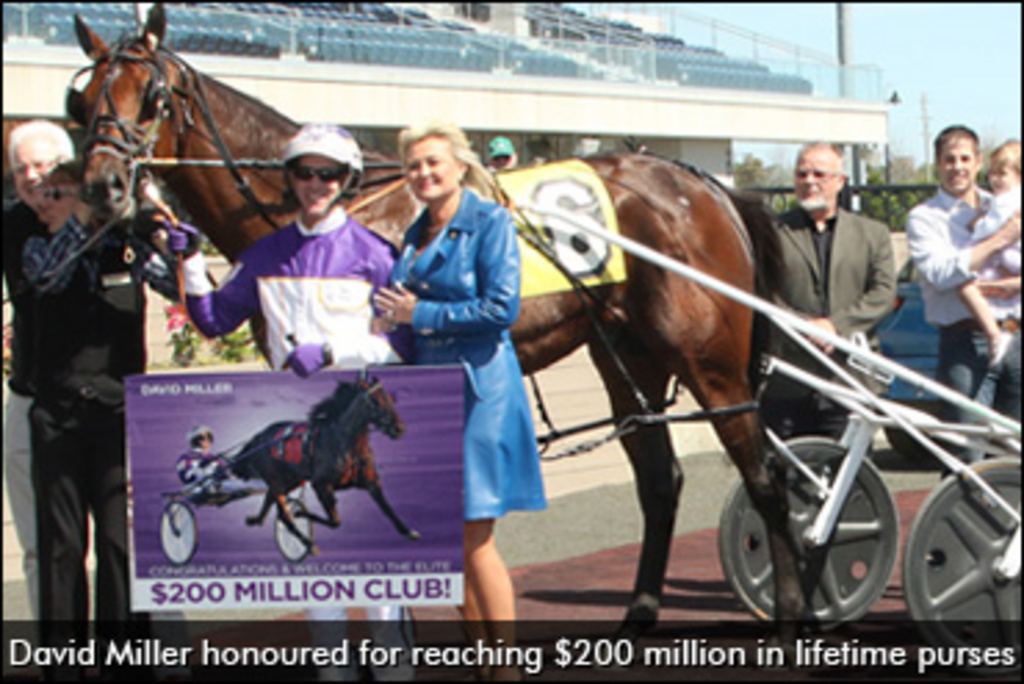David Miller: The $200 Million Man

David Miller chuckled when acknowledging his harness racing career has come a long way since he got his first win in 1981 at Lebanon Raceway.
The 51-year-old Ohio native recently became only the third driver in the sport’s history to surpass $200 million (U.S.) in lifetime purses -- adding another accomplishment to his already Hall of Fame credentials.
Miller exceeded the $200 million mark on May 4 when he won with 40-1 longshot Hickory Chumley at Harrah’s Philadelphia. Miller, who has posted a record 13 years with at least $10 million in purses, joined John Campbell (nearly $296 million) and Ron Pierce ($215 million) as the only drivers with more than $200 million. All three drivers are members of the Harness Racing Hall of Fame.
In addition to ranking third in purses, Miller is sixth in career wins with 11,705. He was the U.S. Harness Writers Association’s Driver of the Year in 2015 and 2003. In 2003, Miller led the sport in purses and drove No Pan Intended to the Pacing Triple Crown and U.S. Horse of the Year honours. No Pan Intended, the last horse to sweep the Pacing Triple Crown, passed away April 29 in Ireland, where he was standing stud prior to going to Australia.
Miller recently spoke about his accomplishments, as well as No Pan Intended and owning a three-year-old trotter with trainer Nifty Norman, with Ken Weingartner of the USTA’s Harness Racing Communications division.
KW: Congratulations on reaching $200 million. How nice was it to accomplish that?
DM: It was real nice. Last year people started telling me I was getting close to it. It’s a big milestone. I’m pretty proud of that.
KW: You’re only the third person to get there, so it’s rare. When you start out driving, I’m sure you couldn’t even imagine a number like that.
DM: Yeah (Laughs). Ain’t that the truth.
KW: And to do it with a win must make it even more special.
DM: It does. I raced him one other time and he was OK, but I didn’t think I would get it on him. It was great. I’m glad he won instead of finishing like fourth and getting it. It was pretty neat, really.
KW: Looking back, what other milestone really stands out to you?
DM: Getting into the Hall of Fame. To be recognized for all your work and dedication, that was something special.
KW: Do you remember your first win vividly?
DM: Yeah, yeah. The horse’s name was Wee Diller. It was at Lebanon. I sat close with him and moved him on the backstretch and he cleared them and won.
KW: Do you remember how much you made on that one?
DM: (Laughs.) I’d imagine that purse was a thousand (dollars) or eleven-hundred. But I don’t remember the purse for sure.
KW: But that was one of the first steps on the journey to $200 million.
DM: Yes it was. I’ve come a long ways.
KW: Changing subjects, it was sad to see the news about No Pan Intended.
DM: That was awful. He was still a young horse; he was only 16. They were pretty excited about getting him over there. I was hoping he would do some good over there. It was too bad.
KW: I’m sure you have special memories with him.
DM: For sure. After I heard about it I went home and I have a tape with a lot of his races and watched them. I texted (trainer Ivan Sugg) my condolences too. It was too bad it had to happen.
KW: What made him so special on the racetrack?
DM: His biggest attribute was that he was a really sound horse and could get around any type of track. And he was tough and fast.
KW: Changing gears again, you have Cufflink Hanover with Nifty (trainer Richard 'Nifty' Norman). Nifty said you picked him out.
DM: I had about five of them picked out at Harrisburg. He was the only one that went in my price range. I must have expensive taste. He only cost $30,000.
KW: What did you like about him?
DM: His breeding. His dam is a sister to CR Kay Suzie. He’s got some pedigree there. I watched his video and then when I went to the sale I looked at him and he was nice. He was put together straight and had a nice body on him and a nice head. He was the last one I had picked out to buy. The other ones were bringing way too much.
KW: I didn’t know you had a budget.
DM: (Laughs.) I paid $100,000 once for a horse, (stakes-winner) Mistery Woman, but I ended up with four partners on her by the time I got done.
KW: He’s eligible to some stakes like the Yonkers Trot and Matron, but not the Hambletonian. Any second thoughts about that?
DM: I never had any interest in putting him in that. He’s fine with what he’s got. I bought him hoping he would be a nice (Pennsylvania) sire stakes horses and that’s what he is. You see it happen, but it’s hard to think you’re going to give $30,000 for one and win the Hambletonian. He’s turned out to be all right though. He can make money with the schedule he has. He’s done well. So far so good.
Photo credit: Lisa Photo. This story courtesy of Harness Racing Communications, a division of the U.S. Trotting Association. For more information, visit www.ustrotting.com.

